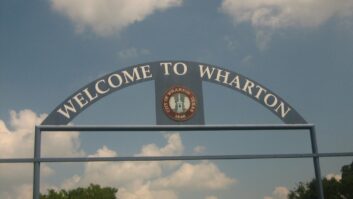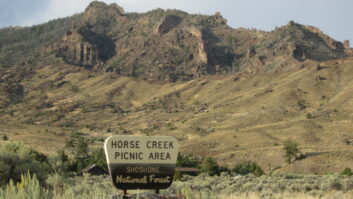Seeking to put the brakes on some of the Federal Communications Commission’s AM ideas, a newly formed group of station owners is urging the commission to consider carefully how it handles revitalization efforts. They believe the FCC has not devoted sufficient study or solicited enough comments over certain issues being considered.
The AM Radio Preservation Alliance includes the country’s largest companies — iHeartMedia, CBS, Cumulus, Alpha Media — and many other big and familiar names: Bonneville, Cox, Entercom, Family Stations, Grand Ole Opry (WSM), Greater Media, Hearst, Hubbard, NRG, Scripps, Townsquare, Tyler Media and Tribune.

The AM Radio Preservation Alliance submitted several audio engineering analyses to the FCC to show that the elimination of current skywave protections would harm regional and distance listeners of Class A AM stations. According to the group, the section in red is the loss area to Class A station WPHT(AM) in Philadelphia from potential nighttime co-channel interference from Class B or D upgrades.
They said the commission must take “only those steps that truly would revitalize the AM band,” and raised concern over two particular issues: the proposal to reduce or eliminate interference protections for Class A AM stations, and the proposal to decrease daytime protections for Class B, C and D AM stations.
As Radio World has reported, iHeartMedia has been vocal about these issues through meetings and calls with the FCC. The formation of the alliance seems to mark a more organized industry effort.
According to the group, the commission did not take sufficient commentary nor devote sufficient study before it concluded in its further notice of proposed rulemaking that all Class A AM stations should be protected only to their 0.1 mV/m groundwave contour from co-channel stations, in lieu of current skywave protections. The alliance also questioned a proposal that suggests that critical hours protections of Class A AM stations should be eliminated completely.
The alliance submitted a series of comments and technical exhibits that detail how the changes would diminish or eliminate the ability of listeners to tune into AM stations. “The proposals to eliminate skywave and critical hours protections, and to reduce Class B, C and D interference protections, would be detrimental to the value to the public of the AM band and thus contrary to the public interest,” the group wrote.
It said the commission should not undermine steps taken so far in the revitalization proceeding by adopting proposals that would create vast new areas of signal interference near and far. “The end result,” the group argued, “would be to drive away existing listeners of the AM band, thereby harming the economic viability of those AM stations providing valued, high-quality programming and key information conduits in the nation’s responses to emergencies.”
The alliance emphasized the role that Class A AM stations have played in providing critical information in times of severe weather and emergency events, noting that those stations are prominently represented as Primary Entry Point and LP-1 stations for government notifications in the FEMA Emergency Alert System. “Diminishing the interference-free service areas of Class A AM stations, as proposed in the FNPRM, would undermine the indispensable role Class A AM stations play in the nation’s emergency alert systems and harm those listeners who rely on Class A AM station’s life-saving emergency warnings,” it wrote.
In its technical exhibits, the alliance reiterated that tens of millions of persons would be subject to new reception-destroying interference on the AM band if skywave protections were eliminated, “driving even more listeners away from the AM dial altogether.”
It also submitted engineering data that said elimination of critical hours restrictions would serve to create immediate, unacceptable interference in the band, even within the close-in groundwave contour of a Class A AM station.
The group also questioned the commission’s proposal to reduce the protected daytime primary service contour for Class B, C and D AM stations to the 2 mV/m contour. “We urge the commission to abandon this proposal to avoid the destructive impact across the AM band that would ensue if adopted.” It said Class B, C and D stations would be faced with high implementation and operating costs for power increases in an effort to stave off encroaching signals, with the public being deluged with more, not less, interference on the band.
The result would be “an unacceptably high interference environment on the AM band, leaving in its wake what can best be described as small islands of service in a sea of interference,” the group said.
“If ever there were a way to drive listeners away from the AM band once and for all, this is it.”
The group also submitted comments from hundreds of listeners expressing support for keeping AM radio interference-free. “Keep the flame-throwing station WLW in full force,” said listener Mary Neubecker, who listens to the Cincinnati AM station from Peoria, Ill. “Do not limit it in any way.”










